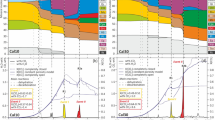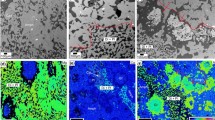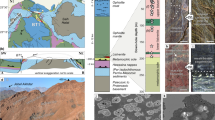Abstract
Metamorphism in deep continental crust is often accompanied by carbon-rich, H2O-poor fluids1–5, and is characterized by the development of granulite facies mineral assemblages3–5. Graphite, a minor phase in many high-grade metamorphic rocks6–17, has also been recognized in recent xenoliths of deep crustal material18, demonstrating its presence in modern deep continental crust. Although graphite is most common in biotite schists, it has also been recorded in pyroxene gneisses, two feldspar-quartz pegmatites, marbles and quartzo-feldspathic gneisses11,15–19. The presence of supracrustal sequences in granulite facies regions6–19 suggests that the latter developed through progressive metamorphism and dehydration of shallow level crustal material. Much of this material must have experienced a metamorphic recrystallization in the amphibolite facies, accompanied by the development of hornblende. Although graphite in the high-grade rock may develop from oxidation of organic material, this may not be the most common means for graphite genesis. In much of West Greenland14 and in southern Norway12 the low-grade, hornblende-bearing material does not contain significant quantities of organic compounds, although graphite is found in higher-grade metamorphic equivalents. This strongly suggests that introducing CO2 into deep crustal material leads to fluid evolution and graphite formation. I outline here the evolution of fluid composition in the C–O–H system which is in equilibrium with common crustal mineral assemblages. Thermodynamic data for CO2–H2O mixtures20 and mineral components21 are used to model the chemical changes in fluid composition which accompany introduction of CO2 into various types of rock. The results demonstrate that graphite genesis is a direct consequence of deep crustal metamorphism in the presence of a CO2-rich fluid phase. In addition, the calculations demonstrate that the deep continental crust will not be a reservoir for large volumes of methane-rich gas.
This is a preview of subscription content, access via your institution
Access options
Subscribe to this journal
Receive 51 print issues and online access
$199.00 per year
only $3.90 per issue
Buy this article
- Purchase on Springer Link
- Instant access to full article PDF
Prices may be subject to local taxes which are calculated during checkout
Similar content being viewed by others
References
Touret, J. Lithos 4, 423–436 (1971).
Goldsmith, J. R. Bull. geol. Soc. Am. 87, 161–168 (1976).
Hollister, L. S. Can. J. Earth Sci. 12, 1953–1955 (1975).
Newton, R. C., Smith, J. V. & Windley, B. Nature 288, 45–52 (1980).
Glassley, W. E. & Sørensen, K. J. Petrol. 21, 69–105 (1980).
Rao, J. S .R. K. & Rao, V. M. Econ. Geol. 60, 1046–1051 (1965).
Katz, M. B. Int. geol. Congr. 24, 43–50 (1972).
Dobner, A., Graf, W., Hahn-Weinheiner, P. & Hirner, A. Lithos 11, 251–255 (1978).
Bessaire, H. in The Precambrian Vol. 3, 133–142 (Wiley, New York, 1967).
Dougan, T. W. Contr. Miner. Petrol. 46, 169–188 (1974).
Heier, K. S. Norg. geol Unders. 207 (1960).
Andreae, M. O. Contr. Miner. Petrol. 47, 299–316 (1974).
Barejee, P. K. & Ghosh, S. Econ. Geol. 67, 55–62 (1972).
Escher, A., Sørensen, K. & Zeck, H. P. The Geology of Greenland, 76–103 (Geological Survey of Greenland, Copenhagen, 1976).
Ailing, H. G. Bull. N.Y.S. Mus. 199, 1–150 (1917).
Cameron, E. N. & Weiss, P. L. Bull. U.S. geol. Surv. 1082-E (1962).
Wynne-Edwards, H. R. Geol. Surv. Can. Mem. 346 (1967).
Padovani, E. & Carter, N. Am. geophys. Un. Monogr. Ser. 20, 19–55 (1977).
Glassley, W. E. & Winter, J. K. EOS 61, 384 (1980).
Kerrick, D. M. & Jacobs, G. K. Am. J. Sci. 281, 735–767 (1981).
Helgeson, H. C., Delaney, J. M., Nesbitt, H. W. & Bird, D. K. Am. J. Sci. 278 A, 229 p. (1978).
Flowers, G. Contr. Miner. Petrol. 69, 315–318 (1979).
Ryzhenko, B. N. & Volkov, V. P. Geochem. Int. 1971, 468–481 (1971).
Wones, D. R. Am. Miner. 57, 316–317 (1972).
Winchell, A. N. Econ. Geol. 6, 218–230 (1911).
Ford, R. B. Econ. Geol. 49, 31–43 (1954).
Mueller, R. F. & Condie, K. C. J. Geol. 72, 400–411 (1964).
Strens, R. G. J. Geol. Mag. 102, 393–406 (1965).
Salotti, C. A., Heinrich, E.-W. & Giardini, A. A. Econ. Geol. 66, 929–932 (1971).
Nagy, B., Zumberge, J. E. & Nagy, L. A. Proc. natn. Acad. Sci. U.S.A. 72, 1206–1209 (1975).
Wada, H. Geochem. J. 11, 183–197 (1977).
Gold, T. J. petrol. Geol. 1, 3–19 (1979).
Soter, S. & Gold, T. Scient. Am. 243, 154–170 (1980).
Author information
Authors and Affiliations
Rights and permissions
About this article
Cite this article
Glassley, W. Fluid evolution and graphite genesis in the deep continental crust. Nature 295, 229–231 (1982). https://doi.org/10.1038/295229a0
Received:
Accepted:
Issue Date:
DOI: https://doi.org/10.1038/295229a0
This article is cited by
-
Lower crustal resistivity signature of an orogenic gold system
Scientific Reports (2021)
-
Ultrahigh Temperature Metamorphic Record of Pelitic Granulites in the Huangtuyao Area of the Huai’an Complex, North China Craton
Journal of Earth Science (2019)
-
Vein graphite deposits: geological settings, origin, and economic significance
Mineralium Deposita (2014)
-
Wollastonite at Nuliyam, Kerala, southern India: a reassessment of CO2-infiltration and charnockite formation at a classic locality
Contributions to Mineralogy and Petrology (1995)
-
Grain-boundary graphite in rocks and implications for high electrical conductivity in the lower crust
Nature (1989)
Comments
By submitting a comment you agree to abide by our Terms and Community Guidelines. If you find something abusive or that does not comply with our terms or guidelines please flag it as inappropriate.



